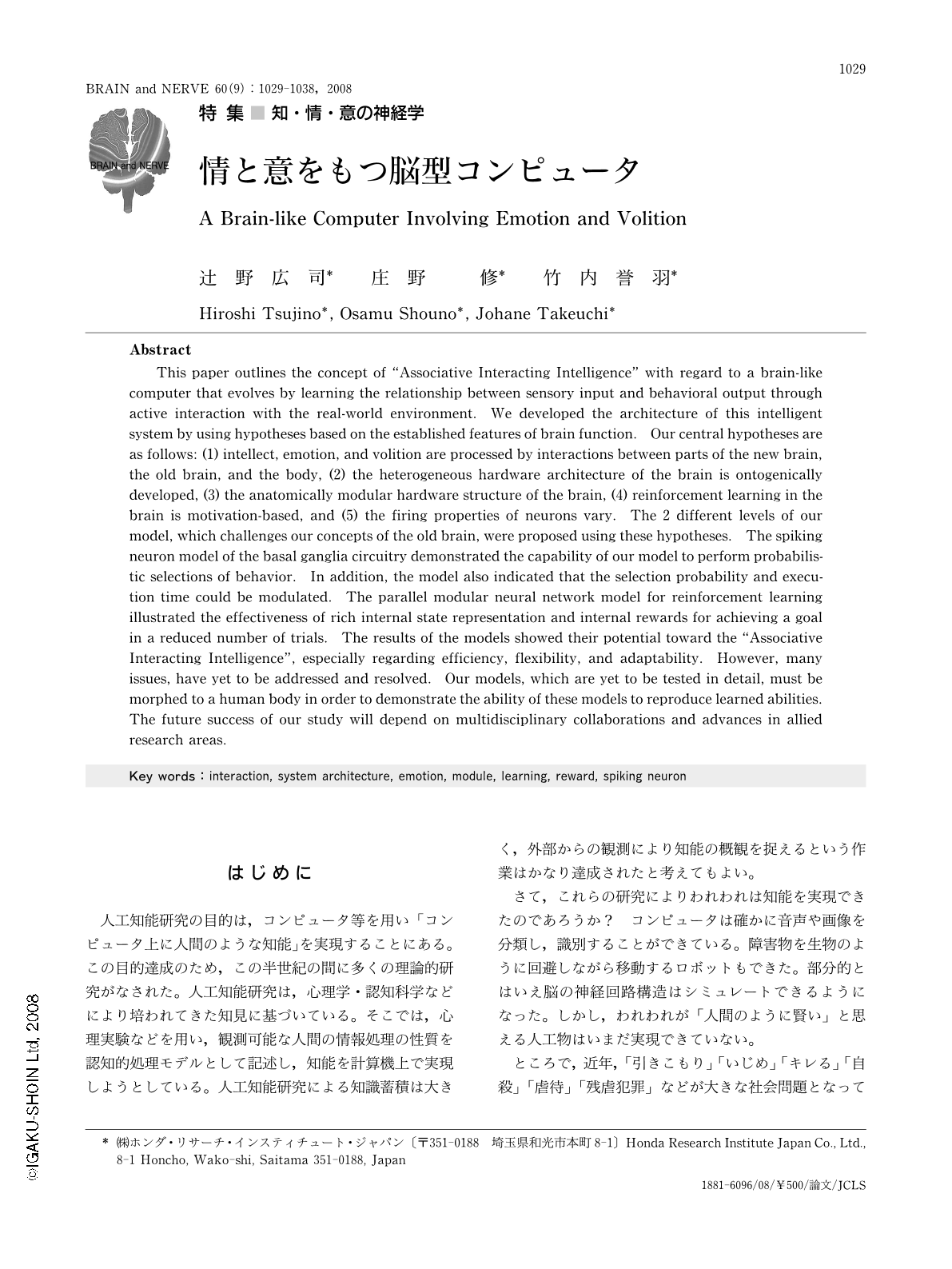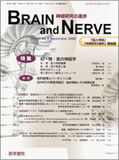Japanese
English
- 有料閲覧
- Abstract 文献概要
- 1ページ目 Look Inside
- 参考文献 Reference
はじめに
人工知能研究の目的は,コンピュータ等を用い「コンピュータ上に人間のような知能」を実現することにある。この目的達成のため,この半世紀の間に多くの理論的研究がなされた。人工知能研究は,心理学・認知科学などにより培われてきた知見に基づいている。そこでは,心理実験などを用い,観測可能な人間の情報処理の性質を認知的処理モデルとして記述し,知能を計算機上で実現しようとしている。人工知能研究による知識蓄積は大きく,外部からの観測により知能の概観を捉えるという作業はかなり達成されたと考えてもよい。
さて,これらの研究によりわれわれは知能を実現できたのであろうか? コンピュータは確かに音声や画像を分類し,識別することができている。障害物を生物のように回避しながら移動するロボットもできた。部分的とはいえ脳の神経回路構造はシミュレートできるようになった。しかし,われわれが「人間のように賢い」と思える人工物はいまだ実現できていない。
ところで,近年,「引きこもり」「いじめ」「キレる」「自殺」「虐待」「残虐犯罪」などが大きな社会問題となっている。また,情動障害,行動障害の子供たちも増えている。このような問題の原因には,いくつもの要素が関与していると考えられるが,その一要素に現在のコンピュータおよびコンピュータ社会も挙げられるのではないだろうか。コンピュータはわれわれの生活に便利さを与えた反面,大切な「人間らしさ」を奪っているようにも思える。現在のコンピュータは計算結果を出力することが目的であり,人間が人間らしさをなくすことに対しては無関心な道具である。その一方,人々の生活の中で長く使用されてきた道具は,その機能目的だけでなく,生活の中での一体感,やさしさ,愛着を持つように発達してきたように思える。そのような意味では,人間の道具としてのコンピュータの歴史はいまだ浅いのであろう。われわれは,今,「コンピュータ上に人間の知能」を実現するよりも「人間の道具としてのコンピュータに必要な知能」を考えるべきなのではないだろうか。そして,それはわれわれの「人間らしさをサポートするもの」であるべきではないだろうか?
筆者らは,「人間らしさ」をサポートし,生活の中での一体感,やさしさ,愛着を醸し出す新しいタイプのコンピュータの実現を目指している。このようなコンピュータは,人が脳に持っているバランスのとれた動作原理に基づいて動作すると考え,その意味で,筆者らは「Brain-like Computer1)」と呼ぶ。バランスとは知・情・意・体のバランスである。知は,情や意によって選択的に脳に蓄えられた記憶表現であり,認識や行動を行う際のデータベースともなる。情は,脳活動を制御し,意欲や学習と関係すると共に,認識や記憶などの処理機構を構成する駆動源である。意は,情と相互作用することで双方向的に意味付けられ,知に基づいた目標設定・意志決定を行う。これら知・情・意は,それらが駆動する体(身体機構,センサ,アクチュエータなど)を通し外界・身体状況と相互作用することで,生活の中での一体感,やさしさ,愛着を獲得していく。このようなバランスがとれた知能こそ,コンピュータに必要な知能であり,筆者らは「Associative Interacting Intelligence(AII)」と呼ぶ。本稿では,AIIの実現を目指し展開している,筆者らの研究を紹介する。
Abstract
This paper outlines the concept of "Associative Interacting Intelligence" with regard to a brain-like computer that evolves by learning the relationship between sensory input and behavioral output through active interaction with the real-world environment. We developed the architecture of this intelligent system by using hypotheses based on the established features of brain function. Our central hypotheses are as follows: (1) intellect, emotion, and volition are processed by interactions between parts of the new brain, the old brain, and the body, (2) the heterogeneous hardware architecture of the brain is ontogenically developed, (3) the anatomically modular hardware structure of the brain, (4) reinforcement learning in the brain is motivation-based, and (5) the firing properties of neurons vary. The 2 different levels of our model, which challenges our concepts of the old brain, were proposed using these hypotheses. The spiking neuron model of the basal ganglia circuitry demonstrated the capability of our model to perform probabilistic selections of behavior. In addition, the model also indicated that the selection probability and execution time could be modulated. The parallel modular neural network model for reinforcement learning illustrated the effectiveness of rich internal state representation and internal rewards for achieving a goal in a reduced number of trials. The results of the models showed their potential toward the "Associative Interacting Intelligence", especially regarding efficiency, flexibility, and adaptability. However, many issues, have yet to be addressed and resolved. Our models, which are yet to be tested in detail, must be morphed to a human body in order to demonstrate the ability of these models to reproduce learned abilities. The future success of our study will depend on multidisciplinary collaborations and advances in allied research areas.

Copyright © 2008, Igaku-Shoin Ltd. All rights reserved.


